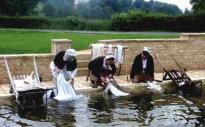L' histoire de Metz et de la Lorraine, histoire de la moselle - cartes postales anciennes de Metz - cartes postales anciennes de Moselle - histoire Moselle

Maison N°5, Rue Taison
Not a job for wet blankets
In the 19th century, alcoholism is a great plague. Many cafes settle in big laundering centres.
Moreover, the profession is demanding. Spending the whole day with half of the body in a wash tub, under the rain, under the snow, with the wind cutting your face; you have to wash anyway... You have your skirts soaked both on the outside and the inside writes V. Hugo in Les Misérables.
Tuberculosis is responsible of more than half of the deaths among the laundresses and pressers infected by the linen, which is hardly disinfected when it arrives at the laundry. Skin lesions, due to the use of corrosive washing products, lower back pain, varicose veins and premature delivery are the common fate of these women carrying too heavy loads and working continuously standing.
These women save money on food and spend their money by knickknack or cake sellers, or by fortune tellers frequenting the workshops. They buy lottery tickets and pay itinerant musicians on fixed dates.
Business is sinking
In Paris, in the 19th century, the off season is long. The small businesses are the ones suffering the most of it, and tend to disappear at the profit of mechanized factories.
Laundering at home becomes more common. Hostels and communities set up laundry rooms with an air dryer in their basements. The advent of washing machines for the familys linen almost makes the profession disappear entirely.
Family business
In 1878, Frédéric Le Play describes the life of a master-launderer working with the help of his wife, his two daughters and a few workers. The quantity of linen the launderer can receive, and deliver in one day with a horse-cab, limits his activities. He works for thirty-five modest families, at most, but serves rather only five or six really well-off houses.
The tools work round the clock
The company uses quite simple tools: a cast iron boiler, a beam called batterie to beat the linen, big, medium and small tubs called tinettes, beaters and buckets. For the ironing: a brick stove with a cast iron cistern, a big ironing board with five trestles, a big table to fold the linen and a board to pile the folded linen up, props or poles to which ropes are fastened in order to hang up the linen,
a wheelbarrow and twenty flat-irons.
A typical week
Each week, on Wednesday, the master-launderer, accompanied by his whole family, brings the linen he has received the previous week to Paris, in a horse-cab. They live in the morning, at five oclock in the summer, at eight oclock in the winter, to get back home only at eight or eleven oclock in the evening, with the linen they have to launder.
On Thursday morning, they proceed to the sorting of the linen. The less dirty pieces are directly soaped by two workers working by the day, the rest of it undergoes a washing that lasts until Friday. As soon as the washing is done, the women take care of the soaping. The launderer, helped by his assistant, carries the linen to where it is hung up.
On Sunday, the whole family takes care of the folding of the linen, which is thus prepared for the ironing. This task is carried out by the women on Monday and Tuesday. In the evening and during the following night, the linen is sorted, and the packets to be delivered to each client are fashioned.
When laundering rimes with wealth
The description of the master-launderers wifes outdoor clothes is evidence of the familys good level of life: On the rare opportunities the wife is given


